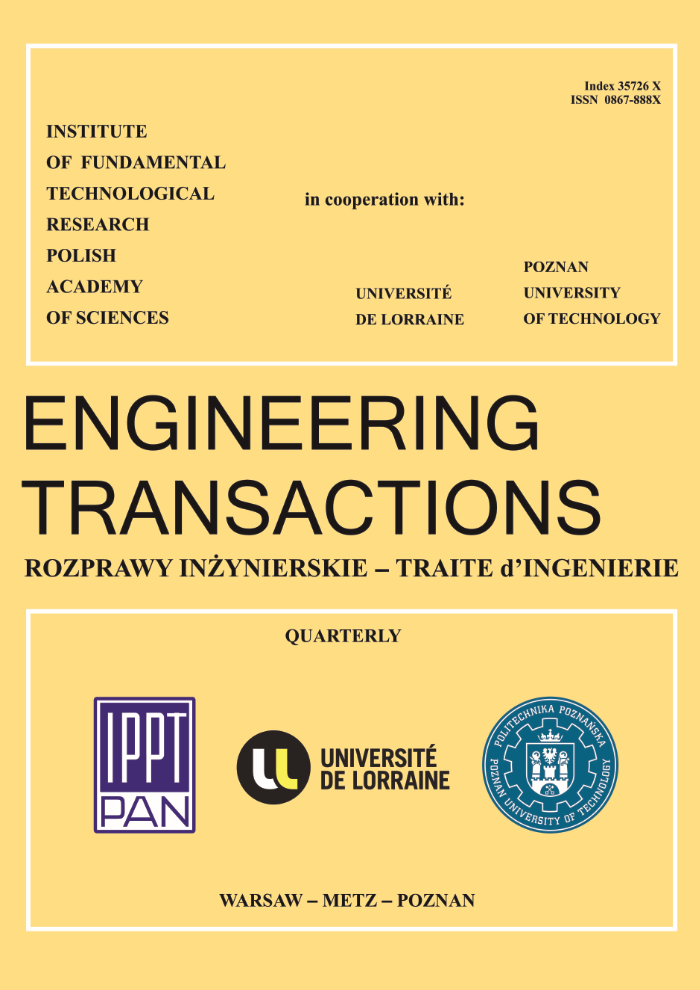Self-Excited Vibrations Counteraction in Machine Tool — Cutting Process System Using Controllable Eliminator of Vibration
Abstract
In the paper, the results of simulation investigations on the application of a semi-active vibration eliminator for suppression of machining chatter are presented. First, the idea of a semi-active vibration eliminator arranged in the "machine tool – cutting process" system (MT–CP) is presented. Next, the results of the identification process of parameters of this system are shown. Properties of the mass-damping-spring system of the machine tool were estimated during the modal testing. A mechanistic model of the cutting process was built on the basis of results of cutting tests. Two control algorithms have been tested: one with the time-invariant model of disturbances (MD) and another with the adaptive model of disturbances. Estimation of the eliminator effectiveness in the suppression of self-excited vibrations in a MT–CP system is also included.Keywords:
vibrostability, semi-active eliminator of vibrationReferences
1. Alter D.M., Tsao T.C., Stability in turning process with actively controlled linear motor feed drives, ASME Journal of Engineering for Industry, 116, 298–307, 1994.
2. Chodżko M., Powałka B., Analiza poloienia biegunów jako metoda oceny wibrostabilnaci systemu obrabiarka – proces skrawania, VIII Szkola Analizy Modalnej, Kraków, 2003.
3. Ehmann K.F., Kapoor S.G., Devor R.E., Lazoglu I., Machining process modeling: a review, ASME Journal of Manufacturing Science and Engineering, 119, 655–663, 1997.
4. Esma S., Marui E., Suppression of chatter vibration of boring tools using impact dampers, Int. Journal of Machine Tools and Manufacture, 4, 1141–1151, 2000.
5. Inamura T., Sato T., Stability analysis of cutting under varying spindle speed, Annals of CIRP, 23, 2, 119–120, 1974.
6. Jemielniak K., Widota A., Suppression of self-excited vibration by the spindle speed variation method, Int. Journal of Machine Tool Design and Research, 24, 119–120, 1984.
7. Liao Y.S., Young Y.C., A new online spindle speed regulation strategy for chatter control, International Journal of Machine Tool Manufacture, 36, 651–660, 1996.
8. Mizuno T., Araki K., Active dynamic vibration absorber with automatic frequency tracking, Transaction Japan Society of Mechanical Engineers, Series C, 41, 3, 378–383, 1998.
9. Pajor M., Chodźko M., Marchelek K., Simulation investigations of the influence of a vibration eliminator on vibrostability of the machine tool-cutting proces system, Zeszyty Naukowe Katedry Mechaniki Stosowanej, No. 13 XXXIX, 279–286, Wisła 2000.
10. Shiraishi M., Yamanaka K., Fujita H., Optimal control of chatter in turning, International Journal of Machine Tools Manufacture, 31, 1, 31–43, 1991.
11. Smith S., Tłusty J., Stabilizing charter by automatic spindle speed regulation, Annals of CIRP, 41, 1, 433–436, 1992.
12. Tanaka H., Obata F., Matsubara T., Mizumoto H., Active chatter suppression of slender boring bar using piezoelectric actuators, JSME 37, 3, 601–606, 1994.
13. Tarng Y.S., Lee E.C., A critical investigation of the phase shift between the inner and outer modulation for the control of machine tool charter, International Journal of Machine Tools Manufacture, 37, 1661–1672, 1997.
14. Tarng Y.S., Kao Y.J., Lee E.C., Chatter suppression in turning operations with a tuned vibration absorber, Journal of Material Processing Technology, 105, 55–60, 2000.
2. Chodżko M., Powałka B., Analiza poloienia biegunów jako metoda oceny wibrostabilnaci systemu obrabiarka – proces skrawania, VIII Szkola Analizy Modalnej, Kraków, 2003.
3. Ehmann K.F., Kapoor S.G., Devor R.E., Lazoglu I., Machining process modeling: a review, ASME Journal of Manufacturing Science and Engineering, 119, 655–663, 1997.
4. Esma S., Marui E., Suppression of chatter vibration of boring tools using impact dampers, Int. Journal of Machine Tools and Manufacture, 4, 1141–1151, 2000.
5. Inamura T., Sato T., Stability analysis of cutting under varying spindle speed, Annals of CIRP, 23, 2, 119–120, 1974.
6. Jemielniak K., Widota A., Suppression of self-excited vibration by the spindle speed variation method, Int. Journal of Machine Tool Design and Research, 24, 119–120, 1984.
7. Liao Y.S., Young Y.C., A new online spindle speed regulation strategy for chatter control, International Journal of Machine Tool Manufacture, 36, 651–660, 1996.
8. Mizuno T., Araki K., Active dynamic vibration absorber with automatic frequency tracking, Transaction Japan Society of Mechanical Engineers, Series C, 41, 3, 378–383, 1998.
9. Pajor M., Chodźko M., Marchelek K., Simulation investigations of the influence of a vibration eliminator on vibrostability of the machine tool-cutting proces system, Zeszyty Naukowe Katedry Mechaniki Stosowanej, No. 13 XXXIX, 279–286, Wisła 2000.
10. Shiraishi M., Yamanaka K., Fujita H., Optimal control of chatter in turning, International Journal of Machine Tools Manufacture, 31, 1, 31–43, 1991.
11. Smith S., Tłusty J., Stabilizing charter by automatic spindle speed regulation, Annals of CIRP, 41, 1, 433–436, 1992.
12. Tanaka H., Obata F., Matsubara T., Mizumoto H., Active chatter suppression of slender boring bar using piezoelectric actuators, JSME 37, 3, 601–606, 1994.
13. Tarng Y.S., Lee E.C., A critical investigation of the phase shift between the inner and outer modulation for the control of machine tool charter, International Journal of Machine Tools Manufacture, 37, 1661–1672, 1997.
14. Tarng Y.S., Kao Y.J., Lee E.C., Chatter suppression in turning operations with a tuned vibration absorber, Journal of Material Processing Technology, 105, 55–60, 2000.






